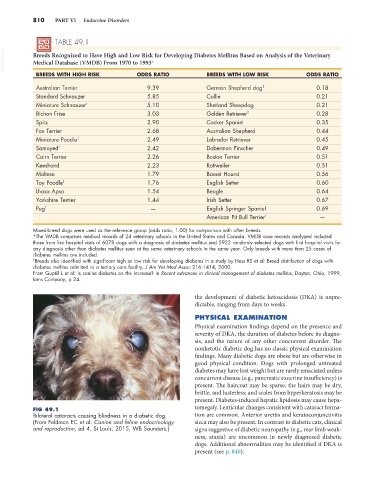Page 838 - Small Animal Internal Medicine, 6th Edition
P. 838
810 PART VI Endocrine Disorders
TABLE 49.1
VetBooks.ir Breeds Recognized to Have High and Low Risk for Developing Diabetes Mellitus Based on Analysis of the Veterinary
Medical Database (VMDB) From 1970 to 1993*
BREEDS WITH HIGH RISK ODDS RATIO BREEDS WITH LOW RISK ODDS RATIO
Australian Terrier 9.39 German Shepherd dog † 0.18
Standard Schnauzer 5.85 Collie 0.21
Miniature Schnauzer † 5.10 Shetland Sheepdog 0.21
Bichon Frise 3.03 Golden Retriever † 0.28
Spitz 2.90 Cocker Spaniel 0.35
Fox Terrier 2.68 Australian Shepherd 0.44
Miniature Poodle † 2.49 Labrador Retriever 0.45
Samoyed † 2.42 Doberman Pinscher 0.49
Cairn Terrier 2.26 Boston Terrier 0.51
Keeshond 2.23 Rottweiler 0.51
Maltese 1.79 Basset Hound 0.56
Toy Poodle † 1.76 English Setter 0.60
Lhasa Apso 1.54 Beagle 0.64
Yorkshire Terrier 1.44 Irish Setter 0.67
Pug † — English Springer Spaniel 0.69
American Pit Bull Terrier † —
Mixed-breed dogs were used as the reference group (odds ratio, 1.00) for comparison with other breeds.
*The VMDB comprises medical records of 24 veterinary schools in the United States and Canada. VMDB case records analyzed included
those from first hospital visits of 6078 dogs with a diagnosis of diabetes mellitus and 5922 randomly selected dogs with first hospital visits for
any diagnosis other than diabetes mellitus seen at the same veterinary schools in the same year. Only breeds with more than 25 cases of
diabetes mellitus are included.
† Breeds also identified with significant high or low risk for developing diabetes in a study by Hess RS et al: Breed distribution of dogs with
diabetes mellitus admitted to a tertiary care facility, J Am Vet Med Assoc 216:1414, 2000.
From Guptill L et al: Is canine diabetes on the increase? In Recent advances in clinical management of diabetes mellitus, Dayton, Ohio, 1999,
Iams Company, p 24.
the development of diabetic ketoacidosis (DKA) is unpre-
dictable, ranging from days to weeks.
PHYSICAL EXAMINATION
Physical examination findings depend on the presence and
severity of DKA, the duration of diabetes before its diagno-
sis, and the nature of any other concurrent disorder. The
nonketotic diabetic dog has no classic physical examination
findings. Many diabetic dogs are obese but are otherwise in
good physical condition. Dogs with prolonged untreated
diabetes may have lost weight but are rarely emaciated unless
concurrent disease (e.g., pancreatic exocrine insufficiency) is
present. The haircoat may be sparse; the hairs may be dry,
brittle, and lusterless; and scales from hyperkeratosis may be
present. Diabetes-induced hepatic lipidosis may cause hepa-
FIG 49.1 tomegaly. Lenticular changes consistent with cataract forma-
Bilateral cataracts causing blindness in a diabetic dog. tion are common. Anterior uveitis and keratoconjunctivitis
(From Feldman EC et al: Canine and feline endocrinology sicca may also be present. In contrast to diabetic cats, clinical
and reproduction, ed 4, St Louis, 2015, WB Saunders.) signs suggestive of diabetic neuropathy (e.g., rear limb weak-
ness, ataxia) are uncommon in newly diagnosed diabetic
dogs. Additional abnormalities may be identified if DKA is
present (see p. 840).

